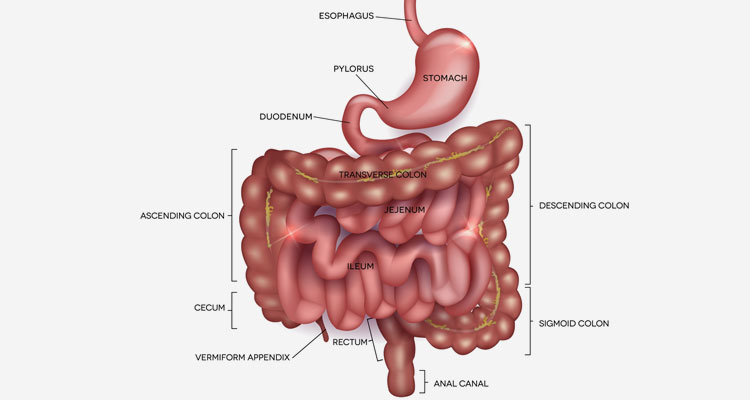Overview
Lower GI bleeding refers to bleeding that occurs from the large intestine, “colon.” It is part of the gastrointestinal tract “GI tract.” It manifests as bright red blood or maroon blood and clots or black tarry bowel movement with or without a stool.
It can sometimes be invisible, in which case it can present as low blood counts, also known as anemia. A particular stool test detects hidden blood.
The level of bleeding can range from mild to severe and can be life-threatening.
Causes
Various causes from lower GI bleeding are:
1. Diverticular disease: This is one of the most common causes of lower GI bleeding. Small pouches can develop in the large intestine. They occur more frequently with age.
2. Angiodysplasias: These are abnormal blood vessels that can cause bleeding from the large intestine. It is the second most common cause of lower GI bleeding.
3. Colon polyps: A small mushroom-like growth can be benign, precancerous, or cancerous. Some of these can develop a presentation with bleeding.
4. Tumors: Benign or malignant/cancerous tumors can develop in the large intestine and cause bleeding as they are present symptom
5. Inflammatory bowel disease (IBD): 2 conditions: Ulcerative colitis, which leads to inflammation and sores in the colon and rectum, and Crohn’s disease, which is also associated with inflammation in various parts of the GI tract but more commonly involves the small and large intestine. When occurring in the large intestine, this can lead to lower GI bleeding.
6. Hemorrhoids: These are swollen veins in your anus or lower rectum. They occur due to hard stools or straining or sitting for a prolonged time on the toilet bowl. Mostly this will be on the toilet paper or the toilet bowl
7. Anal fissures: These are small tears that can occur due to hard stools in the anus. They can lead to the painful passage of bowel movements and associated bright red blood per rectum. Mostly this is on the stool or the toilet paper
Symptoms
Lower GI bleeding can manifest as apparent blood (overt) or sometimes invisible or hidden blood (occult).
Obvious bleeding usually presents bright red blood in the stools, maroon blood, or clots, and sometimes has a black tarry stool.
Hidden blood presents itself in the form of anemia, also known as low blood counts.
Patients who developed new symptoms will usually feel tired and, when bleeding is heavy, could have dizziness or even faintness. Sometimes they will also have associated symptoms of abdominal pain, difficulty breathing, chest pain, or lightheadedness.
When symptoms are severe, this is due to heavy abrupt bleeding, and you can go into shock. Signs of shock can include a drop in blood pressure, rapid pulse, unconsciousness, or reduced urine volume.
Risk Factors
Risk factors for lower GI bleeding can include:
1. NSAID medicines (pain killers)
2. Lack of timely screening for colon cancer and polyps
3. Use of alcohol and smoking
4. Conditions that lead to the development of angioectasias
Diagnostic tests
Several tests are currently available to evaluate evidence of GI bleed or anemia.
1. Blood testing can help determine the level of anemia or hemoglobin.
2. Stool testing can detect blood in your stool that can be invisible.
3. Colonoscopy: This is a test where a thin tube with a light and a camera helps evaluate your large intestine for lesions that can cause bleeding. It can also help to control the bleeding source.
4. Imaging tests: A bleeding scan involves giving you an intravenous chemical that can help detect bleeding in the intestine. A multidetector CT scan can also help detect bleeding in the large intestine.
5. Capsule endoscopy: This test involves ingestion of a capsule with a camera and a light. It transmits images to a recorder worn on your belt. After the test, the capsule will pass out into a bowel movement. However, most people never see it come out.
6. sometimes require conventional angiography
Treatment
Treatment involves several steps.
The first step requires a doctor’s assessment to determine how much blood is lost or the cause of bleeding?
You will get oxygen through a mask on your nose, blood, and fluids into your veins.
Your doctor might stop blood-thinning medications.
Your doctor will do an upper endoscopy, colonoscopy, or both tests. If you have severe bleeding, you may need angiography, an urgent procedure done under a CT scan done by a doctor called a radiologist. Cleaning out of the intestines is not required to perform angiography.
In severe cases, where bleeding is uncontrolled by other means, surgery may remove the part of the intestine. Surgery can be lifesaving.
Once bleeding has been controlled, the doctor will likely follow up with you in the office and treat the condition that has possibly caused the bleeding.
Important Points
Lower GI bleeding presents bright red blood per rectum or maroon blood and rarely as black tarry stools. Sometimes blood can be invisible and present as anemia.
It can occur with or without pain, can be mild or severe. Unfortunately, it can also be sometimes life-threatening.
By following necessary prevention measures like avoiding NSAID medications and getting your screening for colon cancer, you should avoid this condition.
Diagnostic tests include colonoscopy after a cleanout, stool testing, CT scan, etc.
Treatment includes colonoscopy, angiography, embolization, and rarely surgery. After that patient may be put on different medicines depending on the etiology (cause) of the bleeding.








